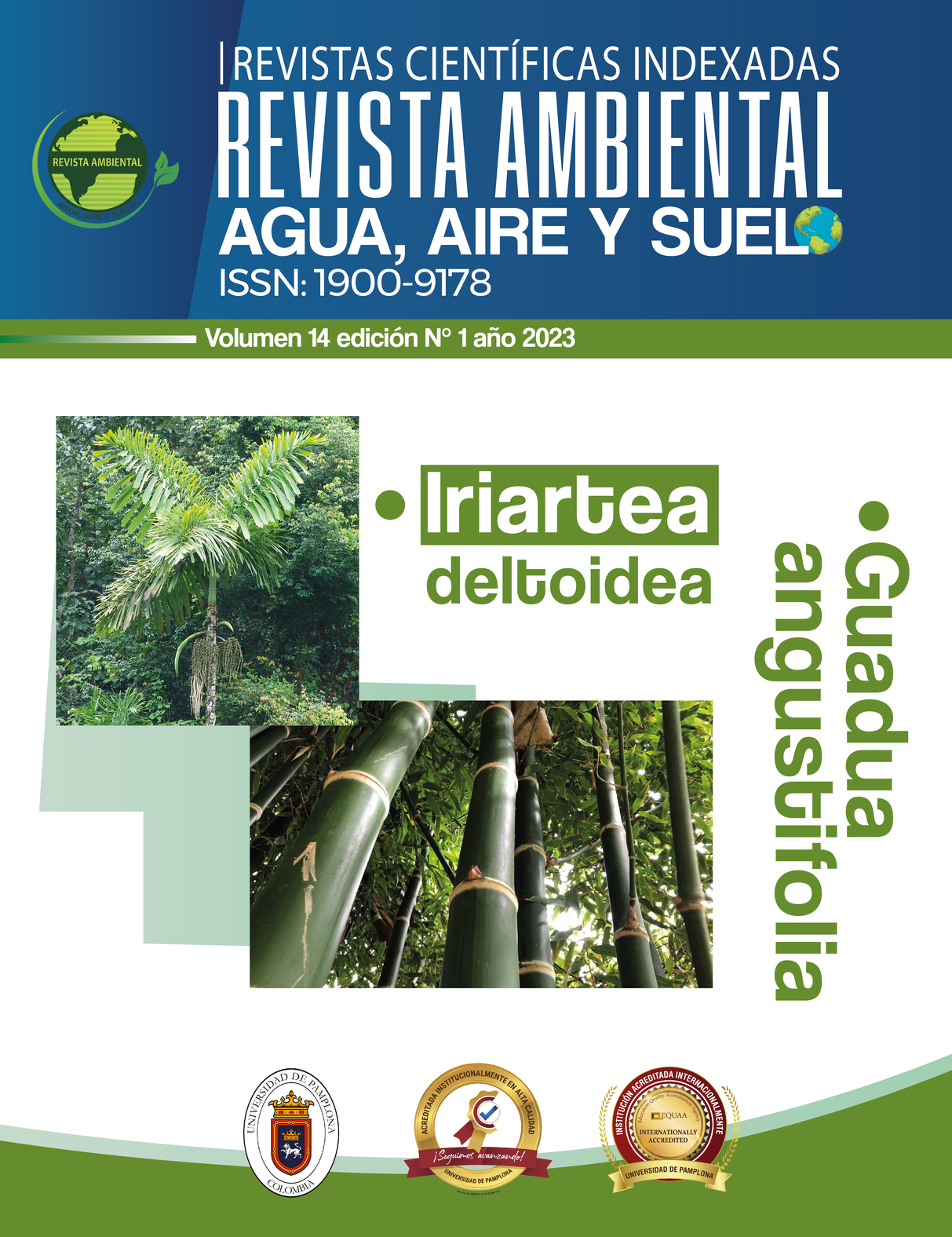Estrategia de conocimiento científico y comunitario para conservación de la diversidad biológica en el sistema lagunar de Cartagena de Indias
DOI:
https://doi.org/10.24054/raaas.v14i1.3006Palabras clave:
Turismo científico, sistema lagunar, diversidad biológica, participación comunitariaResumen
La ubicación de la ciudad de Cartagena otorga particularidades biofísicas específicas, accediendo interiormente a sistemas lagunares conectados y en algunos recorridos tienden a estar encerrados de manglar, formado un sistema biodiverso que atraviesa la ciudad por el barrio Crespo llegando el barrio Manga cruzando por los barrios Marbella, Cabrero, Centro Histórico, Pie de la Popa y Bazurto. La ciudad se considera un corredor biológico conformando por seis masas de agua, conocidos como: caño de Juan Angola, Laguna del Cabrero, Launa de Chambacú, Laguna de San Lázaro, caño de Bazurto y la Ciénaga de las Quintas. La participación de estas comunidades no permitió conocer la percepción sobre la biodiversidad existente a sus alrededores, para comprender las relaciones negativas o positivas que pueden afectar los procesos de turismo y conservación de las especies. El objetivo de la presente investigación es construir una línea base de información de la biodiversidad aplicando conocimiento científico y comunitario en el sistema lagunar de Cartagena de Indias. La estrategia de investigación se basó en el recorrido por el sistema lagunar, en compañía de investigadores, sabedores locales y comunidad en general, inicialmente se estudió la información en base científicas indagadas en CARDIQUE, Establecimiento público Ambiental (EPA), universidades a nivel nacional y a nivel local, artículos científicos, tesis de pregrado y postgrado, colecciones biológicas, páginas web y libros rojos, listas CITES, boletines periódicos, con el fin de generar una matriz de información biológica para el área de estudio y sus aledañas. Posteriormente se relaciona con la comunidad aplicando un aprendizaje colectivo que consiste en investigar mediante la acción participativa un conocimiento real sobre la biodiversidad de la zona, entendiéndolo como un conjunto de fauna, flora y cultura, orientado a la implementación del turismo científico. Como conclusión se generó una base de datos de diversidad biológica, validada por investigadores, sabedores locales y habitantes de la comunidad, alcanzando a identificar 94 especies entre aves, peces, reptiles, mamífero y mangles presentes en el sistema lagunar de Cartagena de Indias, departamento de Bolívar.
Descargas
Referencias
Ateljevic, I.; Pritchard, A. & Morgan, N. (2007) “The critical turn in tourism studies. Innovative research methodologies”. Ed. Elsevier, Luton
Castillo, M. & Lozano, M. (2006) “Apuntes de investigación turística”. Universidad de Quintana Roo, México
Cazes, G. (1989) “Le tourisme internacional: mirage ou stratégie d'avenir?” Hatier, ChampagneArdenne
Corporación Autónoma Regional del Canal del Dique (CARDIQUE), 2005. Plan de ordenamiento y manejo de la cuenca hidrográfica de La Ciénaga de la Virgen (Bolívar-Colombia). Ministerios de Ambiente, Vivienda y Desarrollo Territorial (MAVDT), Colombia Conservación Internacional Colombia,.”, [documento de trabajo], Cartagena de indias, 2005, p. 72.
EPA, 2013. Línea Base De Caracterización y Diagnóstico Del Estado De La Vegetación Urbana Distrito De Cartagena. Observatorio Ambiental de Cartagena de Indias. Establecimiento Público Ambiental, Cartagena. Disponible en: https://observatorio.epacartagena.gov.co/gestion-ambiental/ecosistemas/vegetacion/linea-base-caracterizacion-y-diagnostico-de-la-vegetacion-urbaa/especies-arboreas-encontradas/
EPA, 2015. Diagnóstico inventario de fauna y flora Parque Distrital Ciénaga de La Virgen. Observatorio Ambiental de Cartagena de Indias. Establecimiento Público Ambiental, Cartagena. Disponible en: https://observatorio.epacartagena.gov.co/gestion-ambiental/ecosistemas/proyecto-cienaga-de-la-virgen/diagnostico-inventario-de-fauna-y-flora-parque-distrital-cienaga-de-la-virgen/
EPA, 2015b. Guía ilustrada de árboles de Cartagena. Establecimiento Publico Ambiental. Fundación Asociación de cultivadores de Mangle, Cartagena de Indias. Disponible en: https://epacartagena.gov.co/wp-content/uploads/2016/08/Guia-multimedia-de-vegetacion.pdf
Hall, B. (1983). Investigación Participativa. Conocimiento Popular Y Poder: Una Reflexión Personal. La Investigación Participativa En América Latina.
Instituto de Investigaciones Marinas y Costeras (NVEMAR), 2016. Informe sobre la caracterización biofísica y socioeconómica rápida de las condiciones ambientales de la Ciénaga de las Quintas, Cartagena, Bolívar. Disponible en: https://observatorio.epacartagena.gov.co/ftp-uploads/ga-eco-caracterizacion-biofisica-socioeconomica-cienaga-de-las-quintas.pdf
Leiper, N. (2000) “An emerging discipline”. Annals of Tourism Research 27(3): 805-809
MADS, 2017. Resolución 1912 de 2017, “Por la cual se establece el listado de las especies silvestres amenazadas de la diversidad biológica colombiana continental y marino costera que se encuentran en el territorio nacional, y se dictan otras disposiciones” Ministerio de Ambiente y Desarrollo Sostenible, Colombia. Disponible en: https://www.minambiente.gov.co/wp-content/uploads/2021/10/resolucion-1912-de-2017.pdf
Panosso Netto, A.; Tomillo, F. & Jäger, M. (2011) “Por uma visão crítica nos estudos turísticos”. Revista Turismo em Análise 22(3): pp. 539-560. https://doi.org/10.11606/issn.1984-4867.v22i3p539- 560
Suárez, L., & Beltrán, A. P. (2010). Diagnóstico ambiental de los cuerpos internos de agua de la ciudad de Cartagena de Indias. Fundación Universitaria Tecnológico COMFENALCO. https://www.eumed.net/libros-gratis/2010b/691/index.htm
Tinoco-Sotomayor, A. (2018). Riqueza, Uso Y Amenazas De Mamíferos Medianos Y Grandes En El Distrito De Cartagena De Indias, Colombia. Universidad de Cartagena, Cartagena de Indias, Colombia, 80. http://observatorio.epacartagena.gov.co/wp-content/uploads/2018/11/Trabajo-de-grado_mamíferos-del-Distrito-de-Cartagena_Fauna-Silvestre-1.pdf
Descargas
Publicado
Número
Sección
Licencia
Derechos de autor 2023 REVISTA AMBIENTAL AGUA, AIRE Y SUELO

Esta obra está bajo una licencia internacional Creative Commons Atribución-NoComercial 4.0.










